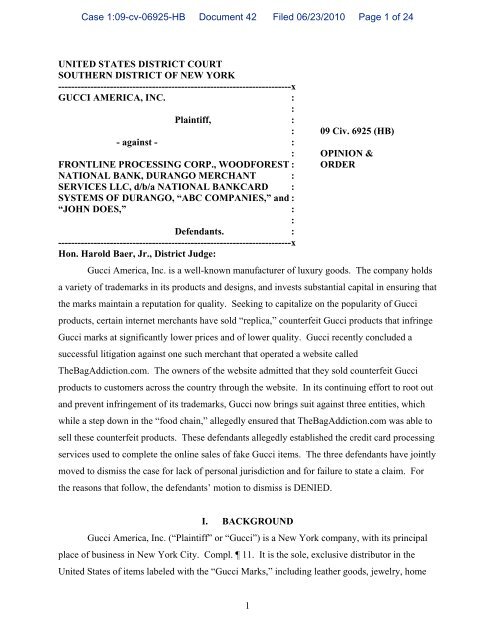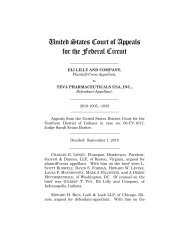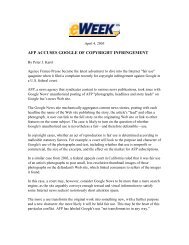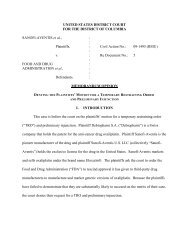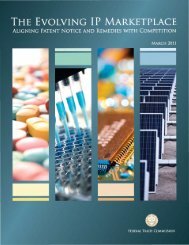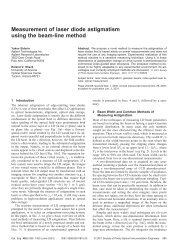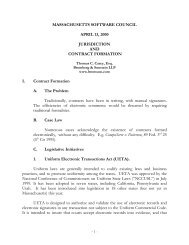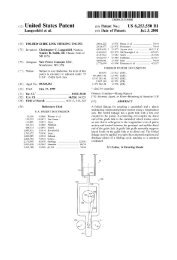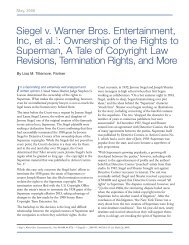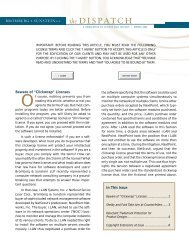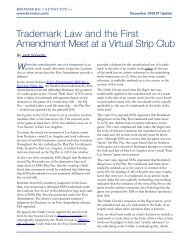Gucci America Inc. v. Frontline Processing Corp
Gucci America Inc. v. Frontline Processing Corp
Gucci America Inc. v. Frontline Processing Corp
You also want an ePaper? Increase the reach of your titles
YUMPU automatically turns print PDFs into web optimized ePapers that Google loves.
Case 1:09-cv-06925-HB Document 42 Filed 06/23/2010 Page 1 of 24<br />
UNITED STATES DISTRICT COURT<br />
SOUTHERN DISTRICT OF NEW YORK<br />
------------------------------------------------------------------------x<br />
GUCCI AMERICA, INC. :<br />
:<br />
Plaintiff, :<br />
: 09 Civ. 6925 (HB)<br />
- against - :<br />
: OPINION &<br />
FRONTLINE PROCESSING CORP., WOODFOREST : ORDER<br />
NATIONAL BANK, DURANGO MERCHANT :<br />
SERVICES LLC, d/b/a NATIONAL BANKCARD :<br />
SYSTEMS OF DURANGO, “ABC COMPANIES,” and :<br />
“JOHN DOES,” :<br />
:<br />
Defendants. :<br />
------------------------------------------------------------------------x<br />
Hon. Harold Baer, Jr., District Judge:<br />
<strong>Gucci</strong> <strong>America</strong>, <strong>Inc</strong>. is a well-known manufacturer of luxury goods. The company holds<br />
a variety of trademarks in its products and designs, and invests substantial capital in ensuring that<br />
the marks maintain a reputation for quality. Seeking to capitalize on the popularity of <strong>Gucci</strong><br />
products, certain internet merchants have sold “replica,” counterfeit <strong>Gucci</strong> products that infringe<br />
<strong>Gucci</strong> marks at significantly lower prices and of lower quality. <strong>Gucci</strong> recently concluded a<br />
successful litigation against one such merchant that operated a website called<br />
TheBagAddiction.com. The owners of the website admitted that they sold counterfeit <strong>Gucci</strong><br />
products to customers across the country through the website. In its continuing effort to root out<br />
and prevent infringement of its trademarks, <strong>Gucci</strong> now brings suit against three entities, which<br />
while a step down in the “food chain,” allegedly ensured that TheBagAddiction.com was able to<br />
sell these counterfeit products. These defendants allegedly established the credit card processing<br />
services used to complete the online sales of fake <strong>Gucci</strong> items. The three defendants have jointly<br />
moved to dismiss the case for lack of personal jurisdiction and for failure to state a claim. For<br />
the reasons that follow, the defendants’ motion to dismiss is DENIED.<br />
I. BACKGROUND<br />
<strong>Gucci</strong> <strong>America</strong>, <strong>Inc</strong>. (“Plaintiff” or “<strong>Gucci</strong>”) is a New York company, with its principal<br />
place of business in New York City. Compl. 11. It is the sole, exclusive distributor in the<br />
United States of items labeled with the “<strong>Gucci</strong> Marks,” including leather goods, jewelry, home<br />
1
Case 1:09-cv-06925-HB Document 42 Filed 06/23/2010 Page 2 of 24<br />
products, and clothing. Id. The <strong>Gucci</strong> Marks are a series of marks –the <strong>Gucci</strong> name, the <strong>Gucci</strong><br />
crest, the “non-interlocking GG monogram,” the “repeating GG design,” etc.– registered by<br />
<strong>Gucci</strong> with the United States Patent and Trademark Office. See Compl. 24-25 (reproduction<br />
of marks), Ex. 1 (Patent Office registration certificates). According to Plaintiff, the marks are<br />
well-known and recognizable in the United States and around the world. <strong>Gucci</strong> promotes the<br />
marks widely, and relies on “strict quality control standards” for its products, and as a result has<br />
achieved and retains a reputation for quality. Id. 28. The company spends hundreds of<br />
millions of dollars to advertise and promote its products and marks, and enjoys billions in sales<br />
of the <strong>Gucci</strong> products. “Based on the extensive sales of the <strong>Gucci</strong> [p]roducts and such products’<br />
wide popularity,” claims Plaintiff, “the <strong>Gucci</strong> Marks have developed a secondary meaning and<br />
significance in the minds of the purchasing public, and the services and products utilizing and/or<br />
bearing such marks and names are immediately indentified by the purchasing public with<br />
Plaintiff.” Id. 30.<br />
This case arises out of Plaintiff’s attempts to eliminate online sales of counterfeit<br />
products and the unauthorized use of the <strong>Gucci</strong> Marks. In <strong>Gucci</strong> <strong>America</strong>, <strong>Inc</strong>., et al. v. Laurette<br />
Company, <strong>Inc</strong>., et al., No. 08 Civ. 5065(LAK), <strong>Gucci</strong> brought suit in this District against certain<br />
defendants, collectively known as the “Laurette Counterfeiters” or “Laurette,” for the sale of<br />
counterfeit <strong>Gucci</strong> products on a website called “TheBagAddiction.com.” 1 Through this website,<br />
the Laurette Counterfeiters sold a variety of “replica” luxury products, and, in particular, sold<br />
replica <strong>Gucci</strong> products under the <strong>Gucci</strong> name, with the various <strong>Gucci</strong> registered trademarks, and<br />
at fractions of the retail price for an authentic version. See Compl. 33-36 (describing and<br />
providing images of counterfeit <strong>Gucci</strong> products sold on TheBagAddiction.com). The website<br />
itself was replete with the use of the <strong>Gucci</strong> name and trademarks. See id. 41 (image of<br />
TheBagAddiction.com website). According to Plaintiff, the Laurette Counterfeiters “openly<br />
boasted” about the sale of counterfeit products, because the website expressly noted that the<br />
products were not authentic but rather “mirror images” of <strong>Gucci</strong> products. See id. 32. Though<br />
they are inferior in quality and workmanship, they appear to the naked eye to be similar if not<br />
identical to <strong>Gucci</strong> products. <strong>Gucci</strong> claims that, as a result of the sale of these counterfeit<br />
products, customers were deceived and misled “into believing that the products sold by the<br />
1 See TheBagAddiction.com, http://www.TheBagAddiction.com. This site can longer be accessed because it was<br />
shut down following <strong>Gucci</strong>’s lawsuit, but archived versions of the website can be browsed at The Internet Archive<br />
Wayback Machine. See http://web.archive.org/web/*/http://thebagaddiction.com (last visted May 23, 2010).<br />
2
Case 1:09-cv-06925-HB Document 42 Filed 06/23/2010 Page 3 of 24<br />
Laurette Counterfeiters on TheBagAddiction.com were authorized or sponsored by the Plaintiff.”<br />
Id. 40. Eventually, Laurette consented to the entry of judgment and admitted liability for<br />
counterfeiting activities. According to Plaintiff, “the Laurette [c]ounterfeiters admitted … that,<br />
without authorization or license … they willfully and intentionally used, reproduced and/or<br />
copied the <strong>Gucci</strong> [m]arks in connection with their manufacturing, distributing, exporting,<br />
importing, advertising, marketing, selling and/or offering to sell their [c]ounterfeit [p]roducts.”<br />
Id. 31.<br />
Plaintiff now seeks to bring the present action against three companies, Durango<br />
Merchant Services, <strong>Frontline</strong> <strong>Processing</strong> <strong>Corp</strong>oration, and Woodforest National Bank 2 , who<br />
allegedly assisted the Laurette Counterfeiters and other similar website operators. Durango<br />
Merchant Services (“Durango”) is a Wyoming corporation with its business address in Durango,<br />
Colorado. According to Defendants, Durango has only five employees, and has no offices, no<br />
employees, and no property located in New York. Durango’s business is predicated on assisting<br />
merchants in setting up credit card processing services with institutions that provide credit card<br />
merchant accounts. Durango does business with New York-based companies, but maintains that<br />
this accounts for less than one percent of its revenue. <strong>Frontline</strong> <strong>Processing</strong> <strong>Corp</strong>oration<br />
(“<strong>Frontline</strong>”) is a Nevada corporation with its principal place of business in Bozeman, Montana.<br />
<strong>Frontline</strong> is a “nationwide provider of credit card processing and electronic payment services for<br />
merchants, banks, and sales agents,” and is an “Independent Service Organization” and<br />
“Merchant Service Provider” with Visa and Mastercard, respectively. Compl. 58. Similar to<br />
Durango, Defendants claim that <strong>Frontline</strong> has no office, no employees, and no property in New<br />
York. A small minority of the businesses it has worked with maintain addresses in New York.<br />
Finally, Woodforest National Bank (“Woodforest”) is a bank organized under the laws of the<br />
United States, with its business address in The Woodlands, Texas. Similar to <strong>Frontline</strong>,<br />
Woodforest also “provides certain credit card processing services.” Id. 14. Like the other two<br />
defendants, Woodforest claims to have no New York offices or property in New York, while a<br />
small percentage of its business comes from New York-based clients. <strong>Gucci</strong> alleges that<br />
Woodforest provides some of its services through an affiliate with an office in New York,<br />
2 <strong>Gucci</strong> also brings suit against certain other “ABC Companies,” unknown companies who engaged with the known<br />
defendants “in the manufacture, distribution, sale, and advertisement of [c]ounterfeit p]roducts,” Compl. 17, and<br />
“John Does,” unknown individuals who also participated with the named defendants in the infringement and<br />
counterfeiting of <strong>Gucci</strong> products. Id. 18.<br />
3
Case 1:09-cv-06925-HB Document 42 Filed 06/23/2010 Page 4 of 24<br />
Merchants’ Choice Card Services <strong>Corp</strong>oration (“MCCS”), though Woodforest disputes the<br />
nature of the relationship.<br />
To understand the roles of the three defendants and their alleged liability, a summary<br />
explanation of the credit card transaction process is necessary. A customer will initiate the<br />
process when he or she purchases a product from the merchant with a credit card. Once the<br />
credit card information is “swiped” on a terminal, or entered on a website, the merchant terminal<br />
transmits an authorization request to the merchant’s “acquiring bank,” who in this case was<br />
<strong>Frontline</strong> and Woodforest. The acquiring bank sends the credit card request through an<br />
electronic network to the cardholder’s issuing bank. Based on the cardholder’s credit limit or<br />
other factors, the issuing bank will send a message back through the network to the acquiring<br />
bank, who forwards it back to the merchant, which states that the merchant should either approve<br />
or decline the transaction. If approved, the merchant will complete the transaction and the<br />
acquiring bank will credit the merchant’s account with the appropriate amount of funds. This<br />
entire process typically takes a matter of seconds. Some days to months after the sale is<br />
completed, the acquiring bank will submit the transaction information to the issuing bank, which<br />
will seek payment from the cardholder and settle with the acquiring bank.<br />
<strong>Gucci</strong>’s overarching theory of the case is that Durango arranged for web companies that<br />
sold counterfeit <strong>Gucci</strong> products to establish credit card processing services with companies like<br />
Woodforest and <strong>Frontline</strong>. These processors then provided the credit card services necessary for<br />
the sale of the faux <strong>Gucci</strong> items. The complaint focuses largely on the allegedly representative<br />
conduct of Defendants with the Laurette Counterfeiters. According to Plaintiff, Durango acted<br />
as an agent for the defendant credit card processing companies 3 to locate potential customers,<br />
including the Laurette Counterfeiters and other similar infringing online operations. Durango<br />
collected a referral fee for bringing together these online merchants with banks and companies<br />
like <strong>Frontline</strong> and Woodforest. Durango’s website billed the company as specializing in services<br />
for “High Risk Merchant Accounts,” including those who sell “Replica Products.” Compl. 48.<br />
<strong>Gucci</strong> alleges that the Laurette Counterfeiters entered into a “Merchant Service Agreement” with<br />
Durango through one of its sales representatives, Nathan Counley and, through this relationship,<br />
“procur[ed] merchant accounts with credit card processing agencies, including Defendants<br />
3 Neither party has provided sufficiently clear terminology to describe Woodforest or <strong>Frontline</strong>. For the purposes of<br />
this opinion, terms like “acquiring bank” and “credit card processors” are intended to have the same meaning and do<br />
not imply anything about their services beyond what is alleged in the complaint.<br />
4
Case 1:09-cv-06925-HB Document 42 Filed 06/23/2010 Page 5 of 24<br />
<strong>Frontline</strong> and Woodforest.” Id. 51. <strong>Gucci</strong> asserts that, through email and other documents,<br />
Durango was aware that TheBagAddiction.com sold counterfeit “replica” <strong>Gucci</strong> products and<br />
nevertheless chose to do business with them.<br />
<strong>Frontline</strong> began to provide credit card processing services to TheBagAddiction.com in<br />
September 2006. The relationship was precipitated by an application completed by the Laurette<br />
Counterfeiters through the assistance of Durango; Counley was listed as a sales agent for<br />
<strong>Frontline</strong> on the application. See Compl. 55. Once the service was established, <strong>Frontline</strong><br />
processed Visa, MasterCard, Discover, and <strong>America</strong>n Express credit card transactions for goods<br />
sold by the Laurette Counterfeiters. <strong>Frontline</strong> deducted a fee, or discount rate, based on the<br />
transactions it processed. As part of its services, <strong>Frontline</strong> would investigate “chargebacks” –a<br />
credit card charge that is disputed by a customer– made in connection with orders from the<br />
website. When faced with a chargeback, Laurette allegedly gave detailed documentation to<br />
<strong>Frontline</strong>, including a description of the item purchased and the price that was paid. Since<br />
<strong>Frontline</strong> credited Laurette’s account after a credit card transaction was authorized, but before it<br />
received any final payment from the issuing bank, it required Laurette to keep a “reserve<br />
account” for chargebacks. The account allegedly totaled in excess $40,000 by the time it was<br />
shut down in June 2008. Allegedly funded “solely through the proceeds from counterfeit goods<br />
sold on” the website, <strong>Frontline</strong> supposedly took possession of these funds when<br />
TheBagAddiction.com was shut down. <strong>Gucci</strong> also alleges that <strong>Frontline</strong> charged a higher<br />
transaction fee, or discount rate, for processing credit cards for high risk merchants, such as<br />
“replica” merchants like the Laurette Counterfeiters. <strong>Frontline</strong> was the only credit card<br />
processor used by the Laurette Counterfeiters for TheBagAddiction.com from September 2006 to<br />
November 2006, and Laurette continued to use <strong>Frontline</strong> until they were shut down in June 2008.<br />
According to Plaintiff, Laurette’s sales of counterfeit <strong>Gucci</strong> products from September 2006 to<br />
June 2008 totaled in excess of $500,000.<br />
Laurette allegedly sought to do business with Woodforest because of the high discount<br />
rate it was charged by <strong>Frontline</strong>. The Laurette Counterfeiters applied for an account with<br />
Woodforest in November 2006; again Counley from Durango was listed on the application, this<br />
time as Woodforest’s sales agent. See Compl. 72. As part of the process, Woodforest<br />
employees reviewed the application and completed an “Internet Merchant Review Checklist.”<br />
The checklist required the employee to review the website and confirm that it contained a<br />
5
Case 1:09-cv-06925-HB Document 42 Filed 06/23/2010 Page 6 of 24<br />
“complete description” of the goods offered, and pages of the website were printed in support of<br />
this review. <strong>Gucci</strong> alleges that Woodforest, through its employee, printed a number of pages<br />
from TheBagAddiction.com that displayed the <strong>Gucci</strong> Marks and counterfeit <strong>Gucci</strong> products. A<br />
second-level review of the website was allegedly performed after Woodforest accepted the<br />
application. An employee or agent would complete a purchase on the website and request a<br />
refund; this process was repeated regularly over the relationship with the online merchant.<br />
Woodforest began processing credit card transactions –Visa, MasterCard and <strong>America</strong>n<br />
Express– for the Laurette Counterfeiters in November 2006, and continued to provide these<br />
services until June 2008 when the website was shut down. Like <strong>Frontline</strong>, Woodforest also<br />
investigated chargebacks and received relevant documentation from Laurette, though <strong>Gucci</strong><br />
claims that MCCS was responsible for processing the chargeback requests. Also akin to<br />
<strong>Frontline</strong>, Woodforest charged a higher discount rate for replica merchants like Laurette.<br />
Woodforest allegedly processed over $1 million in transactions for counterfeit items, and made<br />
over $30,000 from the fees on these transactions.<br />
<strong>Gucci</strong> maintains that the credit card processing services established by these three<br />
defendants was essential to the Laurette Counterfeiters’ sale of counterfeit <strong>Gucci</strong> products.<br />
These services “facilitated the Laurette Counterfeiters ability to quickly and efficiently transact<br />
sales for [c]ounterfeit [p]roducts through their website by enabling customers to use personal<br />
credit cards to pay for purchases on TheBagAddiction.com.” Compl. 87. Without credit card<br />
processing, Plaintiff claims, websites like TheBagAddiction.com could not operate or<br />
functionally exist. As such, <strong>Gucci</strong> believes that Durango, <strong>Frontline</strong>, and Woodforest are equally<br />
responsible for the infringement and counterfeiting engaged in by Laurette through their website.<br />
Based on these allegations, Plaintiff brings causes of action for (1) trademark infringement and<br />
counterfeiting under the Lanham Act, 15 U.S.C. §§ 1114, 1125, 1116, 1117; (2) contributory<br />
trademark infringement and counterfeiting pursuant to the Lanham Act; (3) vicarious liability for<br />
trademark infringement and counterfeiting under the Lanham Act; and (4) trademark<br />
infringement and unfair competition under New York state law, see N.Y. Gen. Bus. Law §§ 360-<br />
k, 360-o. Defendants jointly moved to dismiss these claims based on a purported lack of<br />
personal jurisdiction, and because Plaintiff has failed to state a claim, pursuant to Rule 12(b)(2)<br />
and (6) of the Federal Rules of Civil Procedure.<br />
6
Case 1:09-cv-06925-HB Document 42 Filed 06/23/2010 Page 7 of 24<br />
II. DISCUSSION<br />
A. Personal Jurisdiction<br />
1. Legal Standard<br />
On a motion to dismiss for lack of personal jurisdiction, pursuant to Rule 12(b)(2), the<br />
plaintiff bears the burden of showing that the court has jurisdiction over the defendants. See<br />
Grand River Enters. Six Nations, Ltd. v. Pryor, 425 F.3d 158, 165 (2d Cir. 2005); Kernan v.<br />
Kurz-Hastings, <strong>Inc</strong>., 175 F.3d 236, 240 (2d Cir. 1999). “Where, as here, a court relies on<br />
pleadings and affidavits, rather than conducting a ‘full-blown evidentiary hearing,’ the plaintiff<br />
need only make a prima facie showing that the court possesses personal jurisdiction over the<br />
defendant.” DiStefano v. Carozzi North <strong>America</strong>, <strong>Inc</strong>., 286 F.3d 81, 84 (2d Cir. 2001); see also<br />
PDK Labs, <strong>Inc</strong>. v. Friedlander, 103 F.3d 1105, 1108 (2d Cir. 1997) (“Moreover, we construe the<br />
pleadings and affidavits in plaintiff's favor at this early stage.”). Personal jurisdiction is<br />
necessarily a fact-sensitive inquiry dependent on the particulars of the case before the court. See<br />
PDK Labs, 103 F.3d at 1108.<br />
Pursuant to the Federal Rules of Civil Procedure, “[a] court may exercise jurisdiction<br />
over any defendant who could be subjected to the jurisdiction of a court of general jurisdiction in<br />
the state in which the district court is located.” Wiwa v. Royal Dutch Petroleum Co., 226 F.3d<br />
88, 94 (2d Cir. 2000) (internal quotations omitted); Fed.R.Civ.P. 4(k)(1)(a). “Where a defendant<br />
resides outside the forum state, a federal court applies the forum state’s personal jurisdiction<br />
rules if the federal statute does not specifically provide for national service of process.” PDK<br />
Labs, 103 F.3d at 1108; see also Sunward Elecs., <strong>Inc</strong>. v. McDonald, 362 F.3d 17, 22 (2d Cir.<br />
2004). The jurisdictional analysis is a two-step inquiry. First, the court must determine whether<br />
the plaintiff has shown that the defendants are amenable to service of process under the forum<br />
state’s laws. Second, the court must assess whether the assertion of jurisdiction comports with<br />
the requirements of constitutional due process. See, e.g., Kernan, 175 F.3d at 240; Metro. Life<br />
Ins. Co. v. Robertson-Ceco <strong>Corp</strong>., 84 F.3d 560, 567 (2d Cir. 1996).<br />
2. The Defendants Are Amenable To Jurisdiction Under New York Law<br />
New York’s long-arm jurisdiction statute provides for service of process for defendants<br />
based on both general and specific jurisdictional grounds. The jurisdictional facts presently<br />
before this Court indicate that jurisdiction is most clearly available pursuant to §302(a)(3)(ii), for<br />
a tortious act committed outside the state that causes injury within the state. Jurisdiction<br />
7
Case 1:09-cv-06925-HB Document 42 Filed 06/23/2010 Page 8 of 24<br />
pursuant to § 302(a)(3)(ii) is predicated on five elements: “(1) [t]he defendant committed a<br />
tortious act outside the state; (2) the cause of action arose from that act; (3) the act caused injury<br />
to a person or property within the state; (4) the defendant expected or should reasonably have<br />
expected the act to have consequences in the state; (5) the defendant derives substantial revenue<br />
from interstate or international commerce.” Sole Resort, S.A. de C.V. v. Allure Resorts Mgmt.,<br />
LLC, 450 F.3d 100, 106 (2d Cir. 2006) (citing LaMarca v. Pak-Mor Mfg. Co., 95 N.Y.2d 210,<br />
214 (2000)); see also Kernan, 175 F.3d at 241. Most of these elements are easily met in this<br />
case, based on the limited burden required at this stage. <strong>Gucci</strong> alleges that each of the<br />
defendants is liable, either directly, as a contributor, or vicariously, for the trademark<br />
infringement and counterfeiting committed by the Laurette Counterfeiters and other similar<br />
online enterprises. A plaintiff “need not actually prove that defendant committed a tort” to<br />
satisfy the first element of § 302(a)(3)(ii), “but rather need only state a colorable cause of<br />
action.” Sole Resort, 450 F.3d at 106 (quoting Bank Brussels Lambert v. Fiddler Gonzalez &<br />
Rodriguez, 305 F.3d 120, 125 (2d Cir. 2002)). Trademark infringement is a tort for jurisdictional<br />
purposes, and the situs of this tort is considered to be where the website, or servers which<br />
maintain the website, are located. See Parker Waichman Alonso LLP v. Orlando Firm, P.C., No.<br />
09 Civ. 7401 (CM), 2010 WL 1956871, at *9 (S.D.N.Y. May 14, 2010) (citing, inter alia,<br />
Energy Brands, <strong>Inc</strong>. v. Spiritual Brands, <strong>Inc</strong>., 571 F. Supp. 2d 458, 470-71 (S.D.N.Y. 2008)); see<br />
also Cable News Network, L.P. v. GoSMS.com, <strong>Inc</strong>., No. 00 Civ. 4812 (LMM), 2000 WL<br />
1678039, at *3 (S.D.N.Y. Nov. 6, 2000). The present factual allegations indicate that<br />
TheBagAddiction.com website was operated from outside of New York, specifically in<br />
California. Since I find that <strong>Gucci</strong> has stated a plausible claim for contributory liability for<br />
trademark infringement, see infra, the first and second elements have been satisfied.<br />
The pleadings are sufficient to demonstrate injury to a person or property within New<br />
York. <strong>Gucci</strong> is a New York corporation with its principal place of business in New York City.<br />
It claims injury based on the confusion and lost sales created in the market by the counterfeits, as<br />
well as the harm from the diminished reputation for the marks due to the inferior quality of the<br />
counterfeits. <strong>Gucci</strong> specifically alleges sales of counterfeit goods to New York-based<br />
consumers. Injury within a state “includes harm to a business in the New York market in the<br />
form of lost sales or customers.” Citigroup <strong>Inc</strong>. v. City Holding Co., 97 F. Supp. 2d 549,<br />
568 (S.D.N.Y. 2000); see also GoSMS.com, 2000 WL 1678039, at *4. Moreover, courts in this<br />
8
Case 1:09-cv-06925-HB Document 42 Filed 06/23/2010 Page 9 of 24<br />
district have specifically held that an allegation of trademark infringement by a New York-based<br />
corporate plaintiff that alleges harm in New York is sufficient to satisfy this element. See<br />
<strong>America</strong>n Network, <strong>Inc</strong>. v. Access <strong>America</strong>/Connect Atlanta, 975 F.Supp. 494, 497 (S.D.N.Y.<br />
1997); Parker Waichman, 2010 WL 1956871, at *9. Plaintiff’s allegations support the third<br />
element for specific jurisdiction under § 302(a)(3)(ii).<br />
Fourth, it is clear that each of the three defendants derive substantial revenue from<br />
interstate or international commerce. The requirement for interstate commerce is intended to<br />
exclude foreign businesses that “are of a local character.” Bensusan Rest. <strong>Corp</strong>. v. King, 126<br />
F.3d 25, 29 (2d Cir. 1997) (quoting legislative history for statute). No specific dollar threshold is<br />
required for the revenue to be deemed substantial, and the main concern is the “overall nature of<br />
the defendant’s business and the extent to which he can fairly be expected to defend lawsuits in<br />
foreign forums.” Parker Waichman, 2010 WL 1956871, at *11. Revenue from interstate and<br />
international commerce may be analyzed as a percentage of total revenues, or as an absolute<br />
number, but neither approach is binding and each case should be decided on its own facts. See<br />
Palace Exploration Co. v. Petroleum Dev. Co., 41 F. Supp. 2d 427, 436 (S.D.N.Y. 1998); Parker<br />
Waichman, 2010 WL 1956871, at *11. In this case, <strong>Gucci</strong> generally alleges that Durango,<br />
Woodforest, and Nationwide hold themselves out as national, if not international, companies that<br />
derive substantial revenue from interstate or international commerce. Using the Defendants’<br />
relationship with Laurette as an example, they note that over 15,000 orders totaling more than $2<br />
million was processed during the period in which they were serviced by <strong>Frontline</strong> and<br />
Woodforest, as established by Durango. Each of the defendants earned revenue from this<br />
relationship, and the relationship appears to be fairly representative of the sort of commerce that<br />
each normally engage in as a regular course of business. Taken together, the allegations, with no<br />
real dispute offered by Defendants, suffice to show that none of these businesses operate on a<br />
purely local basis and derive sufficient revenue in interstate commerce to satisfy jurisdiction.<br />
See GoSMS.com, 2000 WL 1678039, at *5 (“The important fact in this analysis is that<br />
GoSMS.com's operations are international and in no way limited to California.”).<br />
The trickiest element, and primary source of contention with regard to jurisdiction, is<br />
whether or not each or any of the defendants expected or reasonably should have expected<br />
consequences in New York. The test for whether a defendant expects or should reasonably<br />
expect his act to have consequences within the State is an objective one. Kernan, 175 F.3d at<br />
9
Case 1:09-cv-06925-HB Document 42 Filed 06/23/2010 Page 10 of 24<br />
241; see also Capitol Records, LLC v. VideoEgg, <strong>Inc</strong>., 611 F. Supp. 2d 349, 363 (S.D.N.Y.<br />
2009). This forseeability requirement “relates to the forum consequences generally and not to<br />
the specific event which produced injury within the state.” Am. Network, 975 F. Supp. at 497;<br />
see also LaMarca, 95 N.Y.2d at 215. In other words, it “requires that a defendant foresee that its<br />
tortious act will have some consequences in New York, although not necessarily the exact<br />
consequences that occurred.” Capital Records, 611 F. Supp. 2d at 363. The purpose of this<br />
element is to “ensure some link between a defendant and New York State to make it reasonable<br />
to require a defendant to come to New York to answer for tortious conduct committed<br />
elsewhere.” LaMarca, 95 N.Y.2d at 215. 4<br />
<strong>Gucci</strong> has pled sufficient facts to demonstrate that each of the three defendants expected<br />
or should have expected that their business relationships with companies like Luarette, who sold<br />
counterfeit goods over the internet without restriction to any particular state, would have<br />
consequences in New York. Durango bills itself as a nationwide and international service that<br />
connects merchants, particularly high-risk online merchants, to credit card processing entities<br />
like Woodforest and <strong>Frontline</strong>. Moreover, Durango concededly has clients in New York, albeit a<br />
small number of them. It is allegedly a service provider for JP Morgan Chase Bank, who <strong>Gucci</strong><br />
claims has its principal place of business in New York. At oral argument, counsel for Plaintiff<br />
proffered that Durango took on an additional business relationship with a “fake handbag<br />
company” that is located in New York. See Oral Argument Transcript (“Tr”) at 41 (Mar. 3,<br />
2010). These are “tangible manifestations” of Durango’s attempts to reach the New York<br />
market. See Parker Waichman, 2010 WL 1956871, at *10. Further, Durango was generally<br />
aware that the internet businesses it established relationships with, like Laurette and<br />
TheBagAddiction.com, were unrestricted by geography and available through the internet to<br />
consumers in all of the states, including New York. When a product is involved, forseeability<br />
can be met through “concrete facts known to the nondomiciliary that should have alerted it that<br />
4 There is some confusion as to the precise contours of the forseeability requirement. In Kernan, the Second Circuit,<br />
citing a variety of New York cases, determined: “that a defendant's product will find its way into New York does not<br />
satisfy this element, and that purposeful availment of the benefits of the laws of New York such that the defendant<br />
may reasonably anticipate being haled into New York court is required.” Kernan, 175 F.3d at 241. After this<br />
decision, the New York Court of Appeals in 2000 decided LaMarca, which made no mention of purposeful<br />
availament for purposes of statutory personal jurisdiction. See 95 N.Y.2d at 215. The Second Circuit subsequently<br />
noted this omission, but declined to decide whether or not purposeful availment is a necessary component of the<br />
New York statute. See Bank Brussels Lambert v. Fiddler Gonzalez & Rodriguez, 305 F.3d 120, 127 (2d Cir. 2002).<br />
I need not resolve this issue. The due process analysis for jurisdiction likewise requires “purposeful availment” and<br />
I find that it exists in this case for all defendants.<br />
10
Case 1:09-cv-06925-HB Document 42 Filed 06/23/2010 Page 11 of 24<br />
its product would enter the New York market.” Am. Network, 975 F. Supp. at 497. Similarly,<br />
<strong>Gucci</strong> has pled sufficient concrete facts to indicate that Durango knew that its services were<br />
utilized in New York. In a similar situation that involved jurisdiction over a foreign defendant<br />
for contributory copyright infringement, the court noted that “a foreign defendant’s vicarious or<br />
contributory liability for the infringing acts of another within the United States may give rise to a<br />
long-arm jurisdiction under New York law.” Armstrong v. Virgin Records, Ltd., 91 F. Supp. 2d<br />
628, 639 (S.D.N.Y. 2000) (citing Stewart v. Adidas A.G., No. 96 Civ. 6670(DLC), 1997 WL<br />
218431, at *3 (S.D.N.Y. Apr.30, 1997)). Here, Durango, as a national service that works with<br />
companies that transact goods over the internet to states including New York, should have been<br />
aware that it could be hauled into court in this forum based on their alleged contributory liability<br />
for their clients’ infringing conduct.<br />
<strong>Gucci</strong>’s allegations with regard to Woodforest and <strong>Frontline</strong> likewise establish that these<br />
two entities expected or should have expected consequences in this forum. Both companies hold<br />
themselves out as nationwide operations and both have clients in New York (although they stress<br />
that these clients are few in number). In addition, both maintain relationships with New Yorkbased<br />
organizations as part of their credit card processing businesses. According to <strong>Gucci</strong>,<br />
<strong>Frontline</strong>’s website indicates that its “principal bank is HSBC Bank NA (Buffalo, New York)”<br />
while Woodforest allegedly has a subsidiary organization involved in its business, MCCS, that<br />
has an office in New York. 5 See Compl. 14, 22. Most significantly, <strong>Gucci</strong> claims that both<br />
Woodforest and <strong>Frontline</strong> established credit card processing services for TheBagAddiction.com,<br />
as well as similar websites, which sold counterfeit <strong>Gucci</strong> products nationwide, and in particular<br />
to New York customers. An agreement that permits sales in New York, even if it does not<br />
specifically enumerate the state, is an indication of an “attempt to serve the New York market,<br />
even if it did so indirectly.” Kernan, 175 F.3d at 242. Put simply, these allegations indicate that<br />
Woodforest and <strong>Frontline</strong> both knew that their services would be used by customers from any<br />
state who accessed the Laurette website, and should have known that “any state” would include<br />
New York. See, e.g., GoSMS.com, 2000 WL 1678039, at *4 (alleged infringer “reasonably<br />
should have expected the transmittal of trademark and copyright infringing content via the<br />
GoSMS.com service to have consequences in New York for the purposes of CPLR<br />
5 Woodforest strongly disputes that it has any relevant relationship with MCCS. Even after considering their<br />
arguments, however, Woodforest and MCCS’s business relationship is at best nebulous. Regardless, <strong>Gucci</strong>’s factual<br />
pleadings as a whole are sufficiently persuasive to support jurisdiction at this stage of proceedings.<br />
11
Case 1:09-cv-06925-HB Document 42 Filed 06/23/2010 Page 12 of 24<br />
302(a)(3)(ii)”); Cartier v. Seah, LLC, 598 F. Supp. 2d 422, 425 (S.D.N.Y. 2009) (alleged<br />
trademark infringer of Cartier watches subject to personal jurisdiction because it placed<br />
advertisements in national catalog, and foreseeable that it would be distributed at New York<br />
airports).<br />
3. Jurisdiction Satisfies Constitutional Due Process<br />
In addition to satisfying the statutory elements for personal jurisdiction, Plaintiff must<br />
also demonstrate that the jurisdictional reach satisfies constitutional due process. The due<br />
process inquiry contains two parts: the minimum contacts inquiry, and the reasonableness<br />
inquiry. See Parker Waichman, 2010 WL 1956871, at *6; see also Kernan, 175 F.3d at 242<br />
(“The due process clause of the Fourteenth Amendment permits a state to exercise personal<br />
jurisdiction over a non-resident defendant with whom it has certain minimum contacts … such<br />
that the maintenance of the suit does not offend traditional notions of fair play and substantial<br />
justice.”) (internal quotations omitted). This protection “gives a degree of predictability to the<br />
legal system that allows potential defendants to structure their primary conduct with some<br />
minimum assurance as to where that conduct will and will not render them liable to suit.” Metro.<br />
Life, 84 F.3d at 567 (quoting Burger King <strong>Corp</strong>. v. Rudzewicz, 471 U.S. 462, 471-72 (1985)). A<br />
court must balance the strengths of weaknesses of the two due process requirements: “depending<br />
upon the strength of the defendant’s contacts with the forum state, the reasonableness component<br />
of the constitutional test may have a greater or lesser effect on the outcome of the due process<br />
inquiry.” Metro. Life, 84 F.3d at 568.<br />
(a) Minimum Contacts & Purposeful Availment<br />
“Specific jurisdiction is determined by first asking if the claim arises out of or relates to<br />
defendants' contacts with the state, and then showing defendants purposefully availed itself of<br />
the privilege of doing business in the forum so that defendant could reasonably foresee being<br />
haled into the forum's courts.” Mario Valente Collezioni, Ltd. v. Confezioni Semeraro Paolo,<br />
S.R.L., 264 F.3d 32, 37-38 (2d Cir. 2001) (citing Kernan, 175 F.3d at 242-43). <strong>Gucci</strong>’s<br />
allegations are sufficient to demonstrate that all defendants have both minimum contacts with<br />
New York and purposefully availed themselves of the privileges of doing business in this state.<br />
As noted above, Durango has a number of contacts with New York. The company considers<br />
itself to be a nationwide service provider, operates a website that can be viewed in New York,<br />
does business with internet merchants like Laurette who sell goods into New York, and even<br />
12
Case 1:09-cv-06925-HB Document 42 Filed 06/23/2010 Page 13 of 24<br />
have some New York-based clients who they earn revenue from (however insubstantial). It is<br />
clear from these contacts that Durango purposefully availed itself of the benefits of this forum<br />
and should have foreseen that it could be haled into court in New York. Durango’s website is<br />
relatively interactive, and provides the opportunity for anyone, including New York residents, to<br />
apply for services and call or email the company. “Many courts have permitted the exercise of<br />
personal jurisdiction based on a defendant’s interactive website in combination with other<br />
relevant forum contacts.” Chloe v. Queen Bee of Beverly Hills, LLC, 571 F. Supp. 2d 518, 524-<br />
25 (S.D.N.Y.2008) (collecting cases); see also Thomas Publ’g Co. v. Indus. Quick Search,<br />
<strong>Inc</strong>., 237 F. Supp. 2d 489, 492 (S.D.N.Y. 2002) (“If IQS wishes to operate an interactive website<br />
accessible in New York, there is no inequity in subjecting IQS to personal jurisdiction here.”).<br />
Durango took advantage of the New York market because it advertises in New York through its<br />
website, has some New York-based clients, and operates a business that helps allow other<br />
companies to sell goods in New York. That one of those was sued for counterfeiting, which<br />
ultimately led to the present suit in this forum, should not have come as any real surprise.<br />
Woodforest and <strong>Frontline</strong> likewise availed themselves of the benefits of this forum, and<br />
maintain sufficient contacts to support jurisdiction. Like Durango, they operated interactive<br />
websites available in New York, billed themselves as available for nationwide business, and<br />
have a small number of clients in New York. Woodforest and <strong>Frontline</strong> availed themselves of<br />
the benefits of New York as part of a “nationwide market to serve clients,” see Parker<br />
Waichman, 2010 WL 1956871, at *11, and some of those clients allegedly counterfeited <strong>Gucci</strong><br />
products. Moreover, it was their credit card processing systems, according to <strong>Gucci</strong>, that<br />
actually allowed for the purchase of counterfeit products in the New York market. <strong>Gucci</strong> also<br />
alleges that Woodforest and <strong>Frontline</strong> performed due diligence on TheBagAddiction.com, and<br />
therefore knew about the “replica” <strong>Gucci</strong> products that were being sold. Just as a company<br />
“cannot disclaim knowledge of” a subsidiaries use of infringing marks in New York, see<br />
Citigroup, 97 F.Supp.2d at 568, a company also cannot disclaim its knowledge of the potential<br />
locations for the sale of products by websites it chooses to do business with. Woodforest and<br />
<strong>Frontline</strong> allegedly operated a service that allowed customers from anywhere in the United<br />
States, including New York, to purchase goods from websites like TheBagAddiction.com, and<br />
therefore have purposefully availed themselves of this forum.<br />
(b) Reasonableness<br />
13
Case 1:09-cv-06925-HB Document 42 Filed 06/23/2010 Page 14 of 24<br />
To satisfy due process, <strong>Gucci</strong> must also demonstrate that the assertion of jurisdiction<br />
“comports with traditional notions of fair play and substantial justice – that is, whether it is<br />
reasonable under the circumstances of the case.” Kernan, 175 F.3d at 243 (quoting Metro. Life,<br />
84 F.3d at 568). Five factors are considered to determine the reasonableness of jurisdiction: (1)<br />
the burden of jurisdiction on the defendant; (2) the interest of the forum in adjudicating the case;<br />
(3) the plaintiff’s interest in convenient and effective relief; (4) the judicial system’s interest in<br />
obtaining the most efficient resolution of the dispute; and (5) the shared interests of the states in<br />
furthering “social substantive policies.” See Kernan, 175 F.3d at 243; see also Parker<br />
Waichman, 2010 WL 1956871, at *7. Where the other elements for jurisdiction have been met,<br />
dismissals on reasonableness grounds should be “few and far between.” See Metro. Life, 84 F.3d<br />
at 575. The facts as alleged here indicate that jurisdiction would be reasonable in this case.<br />
B. Trademark Infringement Liability<br />
1. Standard of review<br />
To survive a motion to dismiss, a plaintiff must “plead enough facts to state a claim to<br />
relief that is plausible on its face.” Bell Atl. <strong>Corp</strong>. v. Twombly, 550 U.S. 544, 570 (2007). A<br />
facially plausible claim is one where “the plaintiff pleads factual content that allows the court to<br />
draw the reasonable inference that the defendant is liable for the misconduct alleged.” Ashcroft<br />
v. Iqbal, 129 S.Ct. 1937, 1949 (2009). Where the court finds well-pleaded factual allegations, it<br />
should assume their veracity and determine whether they “plausibly give rise to an entitlement to<br />
relief.” Id. at 1950. To decide the motion to dismiss, a court may consider “any written<br />
instrument attached to [the complaint] as an exhibit, materials incorporated in it by reference,<br />
and documents that, although not incorporated by reference, are ‘integral’ to the complaint.”<br />
Sira v. Morton, 380 F.3d 57, 67 (2d Cir. 2004) (internal citations omitted); see also NewMarkets<br />
Partners LLC v. Oppenheim, 638 F. Supp. 2d 394, 404 (S.D.N.Y. 2009). “[W]here the wellpleaded<br />
facts do not permit the court to infer more than the mere possibility of misconduct,”<br />
however, dismissal is appropriate. Starr v. Sony BMG Music Entm’t, 592 F.3d 314, 321 (2d Cir.<br />
2010) (quoting Iqbal, 129 S.Ct. at 1950.).<br />
Pursuant to Section 32 of the Lanham Act, “the owner of a mark registered with the<br />
Patent and Trademark Office can bring a civil action against a person alleged to have used the<br />
mark without the owner’s consent.” Tiffany, <strong>Inc</strong>. v. eBay <strong>Inc</strong>., 600 F.3d 93, 102 (2d Cir. 2010)<br />
14
Case 1:09-cv-06925-HB Document 42 Filed 06/23/2010 Page 15 of 24<br />
(quoting ITC Ltd. v. Punchgini, <strong>Inc</strong>., 482 F.3d 135, 145-46 (2d Cir.)); see also 15 U.S.C. §<br />
1114(1)(a). <strong>Gucci</strong> offers three theories of liability to hold Defendants accountable for the<br />
infringing sales of counterfeit products by others: direct, vicarious, and contributory liability. 6<br />
2. Direct and Vicarious Liability<br />
<strong>Gucci</strong> has not put forth sufficient factual allegations to support trademark infringement<br />
claims based on either direct or vicarious theories of liability. Direct liability for trademark<br />
infringement requires a valid mark entitled to protection under the Lanham Act, and that the<br />
defendant used the mark in commerce in connection with the sale or advertising of goods or<br />
services, without the plaintiff’s consent. 1-800 Contacts, <strong>Inc</strong>. v. WhenU.Com, <strong>Inc</strong>., 414 F.3d<br />
400, 406-07 (2d Cir. 2005) (internal quotations and citations omitted). In addition, Plaintiff must<br />
show that the Defendant’s use of the mark is likely to cause confusion. Id. The problem for<br />
<strong>Gucci</strong> is that there is no indication that any of the defendants actually “used the mark in<br />
commerce.” Knowledge alone of another party’s sale of counterfeit or infringing items is<br />
insufficient to support direct liability, see eBay, 600 F.3d at 103, and there are otherwise no<br />
factual allegations that Durango, Woodforest, or <strong>Frontline</strong> themselves advertised or sold<br />
infringing goods.<br />
<strong>Gucci</strong>’s allegations are also unable to support a claim for vicarious liability. Vicarious<br />
trademark infringement, a theory of liability considered elsewhere but not yet the subject of a<br />
decision by this Circuit, “requires a finding that the defendant and the infringer have an apparent<br />
or actual partnership, have authority to bind one another in transactions with third parties or<br />
exercise joint ownership or control over the infringing product.” Hard Rock Cafe Licensing<br />
<strong>Corp</strong>. v. Concession Servs., <strong>Inc</strong>., 955 F.2d 1143, 1150 (7th Cir. 1992); Perfect 10, <strong>Inc</strong>. v. Visa<br />
Intern. Serv. Ass'n 494 F.3d 788, 807 (9th Cir. 2007); see also Banff Ltd. v. Limited, <strong>Inc</strong>., 869 F.<br />
Supp. 1103, 1111 (S.D.N.Y. 1994) (noting lack of consideration in Second Circuit). Though<br />
<strong>Gucci</strong> has raised a number of factual allegations that indicate that Defendants’ services were<br />
crucial to a website like TheBagAddiction.com’s sale of infringing goods, there is insufficient<br />
evidence to plausibly infer an actual or apparent partnership. The vague, puffery-like references<br />
to a “partnership” between these companies and website merchants are not enough to support<br />
vicarious liability. See Louis Vuitton Malletier, S.A. v. Akanoc Solutions, <strong>Inc</strong>., 591 F. Supp. 2d<br />
6 Federal law and state common law infringement claims are analyzed identically. See, e.g., eBay, 600 F.3d at 102<br />
n.6.<br />
15
Case 1:09-cv-06925-HB Document 42 Filed 06/23/2010 Page 16 of 24<br />
1098, 1113 (N.D. Cal. 2008) (“off-hand references to customers as ‘partners’ is insufficient to<br />
exhibit the type of behavior and relationship that can be considered an actual or apparent<br />
partnership.”). While Defendants may have sufficient control over the sale of counterfeit goods<br />
to support contributory liability, see infra, the facts alleged do not support an inference that they<br />
had the type of control over a company like Laurette as a whole, i.e. akin to joint ownership,<br />
necessary for vicarious liability.<br />
3. Contributory Liability<br />
<strong>Gucci</strong>’s only plausible theory of liability here is contributory trademark infringement.<br />
The Supreme Court has determined that liability can extend “beyond those who actually mislabel<br />
goods with the mark of another.” Inwood Lab., <strong>Inc</strong>. v. Ives Lab., <strong>Inc</strong>., 456 U.S. 844, 853 (1982).<br />
There, a drug manufacturer sold generic versions of a certain brand-name drug in identically<br />
colored pill capsules, with the knowledge that pharmacists would place the pills in brand-name<br />
packaging. In this context, the Court held: “if a manufacturer or distributor intentionally induces<br />
another to infringe a trademark, or if it continues to supply its product to one whom it knows or<br />
has reason to know is engaging in trademark infringement, the manufacturer or distributor is<br />
contributorially responsible for any harm done as a result of the deceit.” Id. at 853-54; see also<br />
eBay, 600 F.3d at 104. As the Seventh Circuit noted, however, the Supreme Court’s test for<br />
contributory liability is not as easily applied to service providers as it is to a manufacturer. See<br />
Hard Rock, 955 F.2d at 1148 (“it is not clear how the doctrine applies to people who do not<br />
actually manufacture or distribute the good that is ultimately palmed off as made by someone<br />
else”); see also Tiffany <strong>Inc</strong>. v. eBay, <strong>Inc</strong>., 576 F. Supp. 2d 463, 504 (S.D.N.Y. 2008) (reversed on<br />
other grounds). While the “intentional inducement” prong of the Inwood test still applies, see<br />
eBay, 600 F.3d at 106, courts have crafted a slightly different test for service providers that<br />
“continue[] to supply its [services] to one whom it knows or has reason to know is engaging in<br />
trademark infringement.” Inwood, 456 U.S. at 853. To avoid imputing liability on truly<br />
ancillary figures like a “temporary help service” that may set up a flea market stand for a<br />
counterfeiting merchant, see Hard Rock, 955 F.2d at 1148, courts in other circuits have<br />
determined that a plaintiff must also show “direct control and monitoring of the instrumentality<br />
used by a third party to infringe the plaintiff’s mark.” See, e.g., Perfect 10, 494 F.3d at 807;<br />
Lockheed Martin <strong>Corp</strong>. v. Network Solutions, <strong>Inc</strong>., 194 F.3d 980, 984 (9th Cir. 1999). While the<br />
Second Circuit has yet to directly contemplate the validity of this modified part of the Inwood<br />
16
Case 1:09-cv-06925-HB Document 42 Filed 06/23/2010 Page 17 of 24<br />
test, I concur with Judge Sullivan that this is a “persuasive synthesis.” See eBay, 576 F. Supp. 2d<br />
at 505-06. As such, <strong>Gucci</strong> can proceed with its action against Defendants if it can show that they<br />
(1) intentionally induced the website to infringe through the sale of counterfeit goods or (2)<br />
knowingly supplied services to websites and had sufficient control over infringing activity to<br />
merit liability.<br />
(a) Intentional Inducement<br />
A party can be held liable for trademark infringement if it intentionally induces another to<br />
engage in trademark infringement. With regards to the role played by Durango, Plaintiff’s<br />
inducement theory is supported by sufficient factual allegations. Durango’s website reaches out<br />
to “high risk merchant accounts,” including those who sell “replica products.” Id. 48. The<br />
website further boasts that 95% of merchant accounts are approved and that Durango<br />
“specialize[s] in hard to acquire accounts.” See Coyle Decl., Ex. 10 (printed copies of Durango<br />
website pages). Similar to the companies that promise the extension of credit or loans to those<br />
who are rejected by traditional lending institutions for having bad credit, <strong>Gucci</strong>’s complaint<br />
suggests that Durango bills itself as a company that sets up a certain quality of business with<br />
credit card processing services that accept these “high risk” clients. These allegations can fairly<br />
be construed as Durango’s attempt to induce less savory businesses, like those who sell<br />
counterfeit “replicas” of luxury goods. Moreover, <strong>Gucci</strong> alleges that Durango’s sales<br />
represenative, Nathan Counley, specifically discussed Laurette’s difficulty in finding a credit<br />
card processor because they were “replica” merchants, which <strong>Gucci</strong> argues was synonymous on<br />
the internet for a counterfeiter. 7 Durango “communicated an inducing message to [its] … users,”<br />
and while there is of yet no evidence that they expressly sought out counterfeiters, <strong>Gucci</strong> has<br />
pled sufficient facts to infer that Durango crafted “advertisement[s] or solicitation[s] that<br />
broadcast[] a message designed to stimulate others to commit violations.” Perfect 10, 494 F.3d<br />
at 801 (discussing contributory copyright infringement, but suggesting later that the analysis<br />
7 Defendants challenge the meaning of both “replica” and “high risk,” and claim that both are much more innocuous<br />
terms than <strong>Gucci</strong> suggests. First, “replica” is in fact often used in conjunction, or interchangeably, with the term<br />
“counterfeit” in case law on trademark infringement. See, e.g., Hermes Int’l v. Lederer de Paris Fifth Ave., <strong>Inc</strong>., 219<br />
F.3d 104, 106 (2d Cir. 2000) (“Appellees Lederer and Artbag sell replicas of various Hermès products”); eBay, 600<br />
F.3d at 100 (Defendant internet auction house has disclaimer that it “does not tolerate” replicas); Akanoc, 591 F.<br />
Supp. 2d at 1103 (“Plaintiff believes that each of them is a counterfeit replica of Plaintiff's products which infringe<br />
Plaintiff's copyrights and trademarks.”). Second, the precise meaning of the term is a fact-specific issue that can be<br />
dealt with through discovery, and I may rely on <strong>Gucci</strong>’s pleadings at this stage of the litigation.<br />
17
Case 1:09-cv-06925-HB Document 42 Filed 06/23/2010 Page 18 of 24<br />
applies to trademark infringement as well). Finally, <strong>Gucci</strong> alleges that Counley and Durango<br />
helped the Laurette Counterfeiters set up a system to avoid chargebacks, which required<br />
customers to check a box that said “I understand these are replicas.” This suggests “affirmative<br />
steps taken to foster infringement” or “that Defendants promoted their payment system as a<br />
means to infringe.” Id. at 800-01.<br />
On the other hand, <strong>Gucci</strong> has failed to plausibly support a claim that either Woodforest or<br />
<strong>Frontline</strong> intentionally induced Laurette to sell counterfeit products. Durango, not Woodforest or<br />
<strong>Frontline</strong>, helped set up the Laurette Counterfeiters with credit card processing services. Though<br />
both companies allegedly advertised for high risk merchants, they did not bring Laurette to the<br />
table the way Durango allegedly did. <strong>Gucci</strong> notes that they both charged higher fees for<br />
processing high risk merchants, and that <strong>Frontline</strong> reviewed the language of the aforementioned<br />
acknowledgement of receipt of a replica product. These claims, however, are not enough to<br />
suggest that either Woodforest or <strong>Frontline</strong> took the affirmative steps necessary to foster<br />
infringement. See Perfect 10, 494 F.3d at 801.<br />
(b) Control and knowledge<br />
Even if a defendant does not seek out and intentionally induce a third-party to commit<br />
trademark infringement, it may still be held liable for the infringement if it supplied services with<br />
knowledge or by willfully shutting its eyes to the infringing conduct, while it had sufficient<br />
control over the instrumentality used to infringe. See eBay, 576 F. Supp. 2d at 505-06; Perfect<br />
10, 494 F.3d at 807. Knowledge in this context means that “a service provider must have more<br />
than a general knowledge or reason to know that its service is being used to sell counterfeit<br />
goods … [s]ome contemporary knowledge of which particular listings are infringing or will<br />
infringe in the future is necessary.” eBay, 600 F.3d at 107. A showing of willful blindness to<br />
this information is also sufficient. Id. at 109-10 (“When [a service provider] has reason to<br />
suspect that users of its service are infringing a protected mark, it may not shield itself from<br />
learning of the particular infringing transactions by looking the other way.”).<br />
Here, <strong>Gucci</strong> has made substantial factual allegations about the knowledge of all three<br />
defendants. These allegations at the very least provide a strong inference that each knew that<br />
Laurette traded in counterfeit products, or were willfully blind to that fact. As described<br />
previously, Durango allegedly held itself out to high risk replica merchants. Its sales agent,<br />
Counley, traded emails with the Laurette Counterfeiters who expressly told him that they were<br />
18
Case 1:09-cv-06925-HB Document 42 Filed 06/23/2010 Page 19 of 24<br />
unable to get credit card services because they sold “replica” items. Counley later wrote back to<br />
say he had found a U.S. bank that “can do replica accounts now.” Compl. 54. Surely, a<br />
connection between an inability to get the services needed to transact goods online and the sale<br />
of replicas should have attracted Durango’s attention.<br />
<strong>Frontline</strong> likewise is alleged to have sufficient knowledge of trademark infringement by<br />
the Laurette Counterfeiters. According to <strong>Gucci</strong>, Laurette completed an application to obtain<br />
<strong>Frontline</strong>’s services, and Nathan Counley, though a Durango employee, is listed as <strong>Frontline</strong>’s<br />
sales agent. Counley “acted as <strong>Frontline</strong>’s agent in soliciting and directing credit card<br />
processing business from replica merchants like the Laurette Counterfeiters” and therefore<br />
<strong>Frontline</strong> may be charged with his knowledge, including his understanding of Laurette’s<br />
difficulty to obtain services for selling replicas. Compl. 56. <strong>Gucci</strong> alleges that the “replica<br />
acknowledgment” described above that was created for the Laurette website with Counley’s<br />
assistance was also reviewed by <strong>Frontline</strong>, who made suggestions as to where they should place<br />
this warning on the website. Even more significantly, <strong>Frontline</strong> allegedly performed its own<br />
investigation of products sold through TheBagAddiction.com as part of <strong>Frontline</strong>’s chargeback<br />
reviews. When faced with a chargeback, <strong>Gucci</strong> claims that <strong>Frontline</strong> received supporting<br />
documentation from Laurette that included information about the specific item ordered,<br />
including a description of the item purchased. Not only did <strong>Frontline</strong> allegedly review the<br />
specific item description, Plaintiff also claims that the relatively small price tag for the item, as<br />
well as specific complaints from customers who made chargebacks about not receiving what the<br />
website purported to sell, e.g. a product made of genuine leather, should have alerted <strong>Frontline</strong><br />
that these were infringing products. These fact-specific claims are enough to at least infer that<br />
<strong>Frontline</strong> knew or consciously avoided knowing that the counterfeit products were sold on<br />
TheBagAddiction.com<br />
<strong>Gucci</strong> claims that Woodforest’s situation is similar to <strong>Frontline</strong>. As was the case with<br />
<strong>Frontline</strong>, Counley represented himself on Laurette’s application as Woodforest’s sales agent.<br />
See Compl. 72. The application itself said that Laurette was a “wholesale/retail designer [of]<br />
handbags,” and listed the supplier as a Chinese bag manufacturer rather than <strong>Gucci</strong>. See Compl.,<br />
Ex. 6. <strong>Gucci</strong> also claims that Woodforest specifically reviewed the website and the products<br />
listed on it as part of its initial decision to do business with Laurette. A Woodforest employee<br />
allegedly completed an “Internet Merchant Review Checklist,” which required him or her to<br />
19
Case 1:09-cv-06925-HB Document 42 Filed 06/23/2010 Page 20 of 24<br />
review the website and confirm whether it contained a complete description of the goods offered.<br />
See Compl. 75. Based on these claims and the website images provided by Plaintiff, even a<br />
cursory review of the TheBagAddiction.com would indicate that they claimed to sell replica<br />
<strong>Gucci</strong> products. Indeed, Plaintiff alleges that Woodforest printed out a number of pages that<br />
displayed goods that were for sale, including counterfeit <strong>Gucci</strong> products, and maintained these<br />
pages as part of their business records. Woodforest would also perform a second-level review,<br />
performed repeatedly after it accepted the business, where an employee would complete a<br />
purchase and request a refund. Finally, like <strong>Frontline</strong>, Woodforest investigated chargeback<br />
disputes and received supporting documentation that allegedly should have tipped them off to the<br />
infringing conduct. These claims are more than sufficient to suggest, at this stage of the<br />
litigation, that Woodforest knew or shielded themselves from the knowledge that Laurette was<br />
selling counterfeit <strong>Gucci</strong> products with their credit card processing system.<br />
The most significant dispute between the parties with regard to contributory liability is<br />
whether any or all of the Defendants had sufficient control over Laurette and<br />
TheBagAddiction.com website to render them liable for the web merchant’s counterfeiting<br />
practices. As noted above, the control element was incorporated by the Seventh Circuit to<br />
establish a limiting principle that would exclude those service providers that do not really<br />
contribute to the infringing conduct; this Circuit has yet to directly consider the merits or<br />
contours of this modified form of the Inwood test. See eBay, 600 F.3d at 105-06 (noting control<br />
element but “assum[ing] without deciding that Inwood’s test for contributory trademark<br />
infringement governs”). Although the concept of control arose out of the flea market context and<br />
is based on common law landlord-tenant tort principles, see Hard Rock, 955 F.2d at 1149-50, the<br />
concept of control is not limited to that context. Inwood “laid down no limiting principle that<br />
would require defendant to be a manufacturer or distributor,” and “whether the venue is online or<br />
in brick and mortar is immaterial.” eBay, 576 F. Supp. 2d at 505; see also Fonovisa, <strong>Inc</strong>. v.<br />
Cherry Auction, <strong>Inc</strong>., 76 F.3d 259, 265 (9th Cir. 1996); Lockheed Martin, 194 F.3d at 984. The<br />
only relevant inquiry is the “extent of control … over the third party’s means of infringement,”<br />
eBay, 576 F. Supp. 2d at 505; Lockheed Martin, 194 F.3d at 984, and courts have found<br />
sufficient control in an array of service contexts. See, e.g., eBay, 576 F. Supp. 2d at 505 (online<br />
auction house); Cartier Intern. B.V. v. Liu, No. 02 Civ. 7926, 2003 WL 1900852, at *3<br />
20
Case 1:09-cv-06925-HB Document 42 Filed 06/23/2010 Page 21 of 24<br />
(S.D.N.Y. 2003) (company that shipped goods for counterfeiter); Akanoc, 591 F. Supp. 2d at<br />
1112 (internet service provider).<br />
Here, Plaintiff provides sufficient factual allegations to establish a claim that Woodforest<br />
and <strong>Frontline</strong> had some control over the directly infringing third-party, but fails to provide<br />
enough facts to show control on the part of Durango. Though <strong>Gucci</strong> has made an adequate<br />
showing of intentional inducement by Durango, there is little indication that they had much<br />
control over the website’s sales process. Durango appears to be the veritable middleman in this<br />
case. Though there allegedly was an ongoing relationship between Durango and the Laurette<br />
Counterfeiters, <strong>Gucci</strong> provides little indication that once Laurette received services from<br />
<strong>Frontline</strong> and Woodforest, Durango had any particular ability to stop or prohibit sales. Plaintiff’s<br />
allegations suggest both inducement and knowledge, but “procuring merchant accounts with<br />
credit card processing agencies,” Compl. 51, does not demonstrate that Durango could<br />
thereafter prevent the sale of any or all of the counterfeit products.<br />
In contrast, <strong>Gucci</strong>’s complaint indicates that <strong>Frontline</strong> and Woodforest’s credit card<br />
processing services are a necessary element for the transaction of counterfeit goods online, and<br />
were essential to sales from TheBagAddiction.com. Although other methods of online payment<br />
exist, such as online escrow-type services like PayPal, 8 generally speaking “credit cards serve as<br />
the primary engine of electronic commerce.” Perfect 10, 494 F.3d at 794. Indeed, <strong>Gucci</strong> points<br />
out that Durango’s website claims that “9 out of 10 people use a credit card for their online<br />
orders.” Compl. 3. As such, without the credit card processing operation set up by these two<br />
defendants, <strong>Gucci</strong> alleges that TheBagAddiction.com would largely have been unable to sell its<br />
counterfeit <strong>Gucci</strong> products. They further support this claim with an affidavit by one of the<br />
website owners, who states that “[a]pproximately 99% of payments from my customers were<br />
made using credit cards.” Kirk Decl. 1. Both <strong>Frontline</strong> and Woodforest processed transactions<br />
for cardholders with major credit card institutions –Visa, MasterCard, and so forth– and,<br />
according to <strong>Gucci</strong>, Laurette sold over $500,000 in counterfeit products “during the time they<br />
utilized Defendants’ merchant bankcard services.” Compl. 44. By processing these<br />
transactions, both companies allegedly earned significant revenue from the transaction fees they<br />
charged. Put another way, “[t]hey knowingly provide a financial bridge between buyers and<br />
sellers of [counterfeit products], enabling them to consummate infringing transactions, while<br />
8 See PayPal, https://www.paypal.com (last visited May 26, 2010).<br />
21
Case 1:09-cv-06925-HB Document 42 Filed 06/23/2010 Page 22 of 24<br />
making a profit on every sale.” Perfect 10, 494 F.3d at 810-11 (Kozinski, J., dissenting). 9<br />
Though both <strong>Frontline</strong> and Woodforest insist they are middlemen with no ability to prevent a<br />
transaction, they do not dispute that they could have simply refused to do business with “replica”<br />
internet merchants, just like the flea market purveyor who refuses to provide a booth to a<br />
counterfeiter. See Compl. 87-89 (Woodforest and <strong>Frontline</strong> “facilitated the Laurette<br />
Counterfeiters ability to quickly and efficiently transact sales for Counterfeit Products through<br />
their website by enabling customers to use personal credit cards to pay for purchases on<br />
TheBagAddiction.com”). According to one of the website operators, “[i]f I did not receive an<br />
approval for a credit card charge, I would not ship the customer’s order.” Kirk Decl. 2. These<br />
allegations indicate that the infringing products “are delivered to the buyer only after defendants<br />
approve the transaction … This is not just an economic incentive for infringement; it’s an<br />
essential step in the infringement process.” Perfect 10, 494 F.3d at 811-12 (Kozinski, J.,<br />
dissenting).<br />
<strong>Frontline</strong> and Woodforest insist that these allegations are insufficient because they do not<br />
allege direct or complete control over the website itself. However, the ability to literally shut<br />
down the website is not needed given the facts of this case. The circuits that have considered<br />
this issue look for control and monitoring over the “instrumentality used … to infringe the<br />
plaintiff’s mark.” Perfect 10, 494 F.3d at 807. Based on <strong>Gucci</strong>’s claims, the instrumentality in<br />
this case is the combination of the website and the credit card network, since both are allegedly<br />
necessary elements for the infringing act – the sale and distribution of the counterfeit good. 10<br />
Defendants’ rely on the fact that, in Perfect 10, the Ninth Circuit declined to hold certain credit<br />
card processors liable for a website’s trademark infringement. There, however, the infringing<br />
conduct was the publication on the website of trademarked images of nude models, and the<br />
distribution occurred via individuals viewing and taking the image directly from the website.<br />
See Perfect 10, 494 F.3d at 796 (“the infringement rests on the reproduction, alteration, display<br />
and distribution of Perfect 10’s images over the internet”); Perfect 10, <strong>Inc</strong>. v. Visa Inter. Serv.<br />
Assoc., No. C 04-00371, 2004 WL 3217732 (N.D. Cal. Dec. 3, 2004) (“Plaintiff alleges that a<br />
number of websites routinely and illicitly publish Plaintiff’s images-and thereby infringe.”).<br />
9 Judge Kozinski’s analysis, like that of the majority in Perfect 10, is largely set in the context of copyright<br />
infringement. However, he later states that his dissent on trademark infringement is based on “precisely the same<br />
reasons.” Perfect 10, 494 F.3d at 822.<br />
10 Indeed, <strong>Frontline</strong> and Woodforest’s credit card processing system were likely integrated to some degree, since<br />
some sort of credit card “portal” necessarily had to be embedded in the website for a customer to make a purchase.<br />
22
Case 1:09-cv-06925-HB Document 42 Filed 06/23/2010 Page 23 of 24<br />
Plaintiff in that case failed or perhaps was unable to allege that the credit card service providers<br />
had the “power to remove infringing material” or “directly stop their distribution” because the<br />
infringement occurred on the website itself and a credit card transaction was not needed for the<br />
website to continue to infringe. See Perfect 10, 494 F.3d at 807. This is not the case here.<br />
Rather, <strong>Gucci</strong>’s allegations indicate that they are concerned primarily with the sale of<br />
tangible counterfeit goods to customers around the country, which allegedly could not be<br />
accomplished without Woodforest and <strong>Frontline</strong>’s ability to process the credit card-based<br />
purchases. In the words of the Supreme Court, these defendants “furnish[ed] the means of<br />
consummating” the trademark infringement. See eBay, 600 F.3d at 104 (quoting William R.<br />
Warner & Co. v. Eli Lilly & Co., 265 U.S. 526, 530 (1924)). While in Perfect 10 the credit card<br />
services may not have been needed for a website to display infringing photographs, the<br />
infringement here occurred through the sale of the counterfeit products. “It’s not possible to<br />
distribute by sale without receiving compensation, so payment is in fact part of the infringement<br />
process.” Perfect 10, 494 F.3d at 814 (Kozinski, J., dissenting). This action resembles cases<br />
with defendants who helped consummate infringing transactions by delivering the counterfeit or<br />
infringing goods to the customer. In Getty Petroleum <strong>Corp</strong>. v. Aris Getty, <strong>Inc</strong>., the First Circuit<br />
found a defendant common carrier contributorily liable because it delivered unbranded gasoline<br />
to gas stations it knew would re-sell the gasoline under the Getty brand name. See 55 F.3d 718,<br />
719 (1st Cir. 1995). Lack of title to the gasoline did not matter; the defendant “supplied[] an<br />
essential factor-physical possession of the property to which the trademark was to be attached.”<br />
Id. at 720. Similarly, these defendants allegedly provided an “essential factor” to the<br />
infringement because the goods could not be sold and shipped without their credit card services.<br />
“[I]t makes no difference that defendants control only the means of payment, not the mechanics<br />
of transferring the material … In a commercial environment, distribution and payment are …<br />
like love and marriage-you can’t have one without the other. If cards don’t process payments,<br />
pirates don’t deliver booty.” Perfect 10, 494 F.3d at 818 (Kozinski, J., dissenting). If, as <strong>Gucci</strong><br />
alleges, the Laurette website was functionally dependent upon Woodforest and <strong>Frontline</strong>’s credit<br />
card processing services to sell counterfeit <strong>Gucci</strong> products, it would be sufficient to demonstrate<br />
the control needed for liability.<br />
* * *<br />
23
Case 1:09-cv-06925-HB Document 42 Filed 06/23/2010 Page 24 of 24


